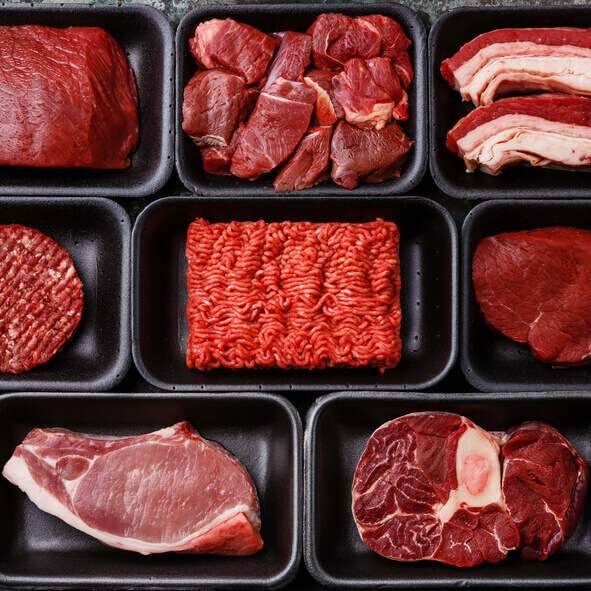How to Store, Freeze, and Thaw Meat the Right Way
The proper storage and refrigeration of food are highly important, especially to anyone in the restaurant industry. However, this looks very different for our clients. For starters, most people don’t have industrial-size refrigerators at home. Also, shelf life is a bit different. If you want burgers, you can run out and get that ground meat the same day. On the other hand, if you have a lot of meat, you won’t go through it as quickly as a restaurant will. Now that the pandemic has changed our way of life in many different ways – it seems prudent to go over how to store, freeze, and thaw meat the right way.
Now, this could be because you want to visit the grocery store less often. Or, you could just require more food while we are at home more. Whatever your reason, here are some great tips to keep you and your meat safe.
Types of Meat
For the purpose of keeping this short and sweet, let’s just discuss the basic meats many households use:
+ Bacon and Sausage – These have the longest shelf life. Bacon can last in your fridge for up to 7 days. However, no matter what the sausage is made of, it is recommended to only keep it for 1-2 days. If anything is smoked, it can also last up to 7 days. These can all last up to a month in the freezer. Smoked meat and sausage can last as long as 2 months if properly frozen.
+ Ground Meat – Because cut-up meat is exposed to more bacteria, it has a shorter shelf life. Any ground or cut-up/cubed meat should be consumed within 1-2 days in the fridge. However, these can last 3-4 months in the freezer.
+ Steak, Pork, Lamb – Large cuts of meat last longer. These can stay up to 3-5 days in the fridge. When frozen immediately, they can last up to a year in your freezer. Though we don’t recommend keeping it that long. Try to use these within 4 months.
+ Chicken, Turkey – It’s best to cook and eat poultry within 1-2 days of buying. However, they can keep in the freezer for 9-12 months. Again, the more ‘whole’ something is the longer it will last.
Storage Tips
There are two places you will find meat in your refrigerator – the fridge and the freezer. First, let’s talk about the fridge. Meat should be stored in the coldest part of the refrigerator, which usually means on the lower shelves. If yours has a special meat drawer, use it. Make sure you keep your refrigerator below 40 degrees. This is optimal to prevent bacteria growth.
Make sure you clean the fridge often and don’t stuff it full of food. While many like the look, it makes your fridge work hard to keep things cool. Also, a vacuum-sealed bag doesn’t prolong the life of your meat. Always assume bacteria already exists within the meat, properly storing it only prevents more bacteria from entering.
If you are unable to use the meat within the recommended time, freeze it.
Freezing Tips
When considering freezing meat, it is best to freeze raw meat. If you are freezing cooked meat, leave it to cool in the refrigerator first so it doesn’t heat up other items in your freezer. We recommend freezing meat as soon as you can. Try to do it per portion. And, do not try to re-freeze meat.
Make sure to use freezer-weight plastic bags or wraps. Light-weight plastic bags allows moisture to leave the meat. This commonly leads to freezer burn. Keep it as air-tight as possible. Also, label the date and ‘use by date’ on everything. The difference in those days tells you how long you can keep the meat after you unthaw it.
Thawing Tips
We have all been there – where we forget to pull the meat out of the freezer and now it’s dinner time. That typically means straight to cooking it or putting it in hot water. Neither of these options is the best way to properly thaw meat. The safest way is to put it in the refrigerator first or give it a cold shower.
Your first choice should always be refrigerator thawing. However, we know this isn’t always realistic. So, if you have to, give it a cold shower. Yes, not a bath. Place it under cool running water as it can carry bacteria away. If that seems wasteful, and you would rather do a bath, then change the water every 20-30 minutes. Moreover, try to avoid keeping meat at room temperature for too long.
It’s About Safety
While there are a lot of quick tricks to thawing meat, remember, these are specific recommendations for your safety. Not only that, but for the best tasting meat. Sometimes trying to rush the process is like rushing smoking meat – the slow and steady win the race. Take your time and store, freeze, and thaw meat the right way.
While many of these you might already know, this isn’t something you learn in school. This is usually handed down from the main cook in the family. While others just might not have known. I hope this helps, and let us know if you have any tricks in the bag!
Share
